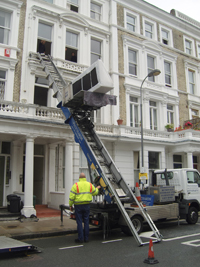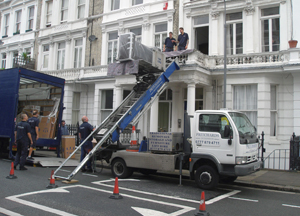An interview with Paul Pritchard on the delights of using external furniture lifts – by Steve Jordan.
 It’s every moving man’s nightmare: a 7ft sofa on the 5th floor that won’t fit in the lift. There is an answer of course, use a furniture lift, but many movers have little experience of using them and wouldn’t have a clue how to start
It’s every moving man’s nightmare: a 7ft sofa on the 5th floor that won’t fit in the lift. There is an answer of course, use a furniture lift, but many movers have little experience of using them and wouldn’t have a clue how to start
Paul Pritchard is the Managing Director of Pritchards of London. For eleven years his company has hired furniture lifts to the trade, not just in London but all over the country. Having caught him during a short lull in his busy day, he explained when a lift should be used and how movers should go about it.
Paul explained that an external lift is usually used for moves from apartment buildings, up to the 9th floor, where the use of the lift in the building is impractical or impossible. They can also be used when there is a significant danger of causing unacceptable damage to a stair well by repeatedly carrying furniture up or down.
“Even if you could use a lift or the stairs you have to balance the cost of manpower against the cost of hiring a lift,” he said. Paul also explained that you have to consider more than just the cost of the labour. “If a key member of staff has to take time off work because he’s damaged his back trying to lug a heavy piece of furniture up stairs, it can cost a lot more than a few hour’s wages.” It doesn’t do much for employee relations either. There might be other considerations as well, especially if the lift or stairs are busy. “Hogging the lift all day can make the movers pretty unpopular with other residents or delivery people,” said Paul.
So an external lift should be considered if some of the furniture is too big to go down the stairs or in the lift; or if using the lift or stairs is impractical because of time restrictions, cost, or just because it will annoy the neighbours too much.
 If you want to use an external lift, you need to plan ahead. You will need to get permission from the building management company or landlord and you’ll probably need to do a risk assessment and method statement. You should always check to find out exactly what’s required. Similarly you will need to take a good look outside to make sure the road is suitable and that there are no trees, lamp posts or telephone cables in the way. You’ll need parking permission anyway but you’ll also need to check you have enough space for the footprint of the lift. The good news is that Pritchards will do all this tricky stuff for you, for an additional fee. “It’s probably best if we handle all that for the hirer; that way we know it’s all been done and we are not going to have any embarrassing difficulties on the day,” said Paul.
If you want to use an external lift, you need to plan ahead. You will need to get permission from the building management company or landlord and you’ll probably need to do a risk assessment and method statement. You should always check to find out exactly what’s required. Similarly you will need to take a good look outside to make sure the road is suitable and that there are no trees, lamp posts or telephone cables in the way. You’ll need parking permission anyway but you’ll also need to check you have enough space for the footprint of the lift. The good news is that Pritchards will do all this tricky stuff for you, for an additional fee. “It’s probably best if we handle all that for the hirer; that way we know it’s all been done and we are not going to have any embarrassing difficulties on the day,” said Paul.
Most apartment buildings, especially in London, have sash windows and it will usually be necessary to remove the window before you start. Again this is something that the lift supplier can do as part of the service but you need to let the customer know that there could be some damage. “Sometimes it’s impossible to avoid damage to the beading on sash windows because age can make them very brittle,” said Paul. “Before the move starts the mover should get the home owner to sign a disclaimer absolving them from any responsibility should a small amount of damage occur.”
When the lift arrives on moving day it will be accompanied by an operator who will be responsible for positioning and operating the lift safely. He probably won’t be helping you do the removal: he’s just there to operate the lift; he’s not an extra pair of hands for the day. It will be your job to load the platform (whether flat or boxed in) and to secure the load each time the lift is used. If something drops off the lift and is broken, or damages something (or somebody) else, that’s your fault not the fault of the lift supplier. “It’s a balance between safety and speed,” said Paul. “Most people don’t strap down every item on every lift, it would take too long. If you are moving a lot of small cartons you are probably best with a boxed-in platform so you can make the best use of the space available.”
 How much weight the platform can take will depend upon the height and the angle at which it’s working. “Most platforms have a maximum weight of around 400 kg assuming they are working up to the 5th floor and at an angle of around 60°. But some lifts will reach as high as 30 metres (around the 9th floor) so the weight carried will vary. When platforms are working at their height limit it’s often necessary to have a second operator to handle a brace line attached to the platform to prevent excessive movement. “Some of the new lifts are designed so they don’t need to be braced in this way,” explained Paul.
How much weight the platform can take will depend upon the height and the angle at which it’s working. “Most platforms have a maximum weight of around 400 kg assuming they are working up to the 5th floor and at an angle of around 60°. But some lifts will reach as high as 30 metres (around the 9th floor) so the weight carried will vary. When platforms are working at their height limit it’s often necessary to have a second operator to handle a brace line attached to the platform to prevent excessive movement. “Some of the new lifts are designed so they don’t need to be braced in this way,” explained Paul.
The lifts are delivered on a specially converted flat-bed lorry that is fitted with hydraulic stabilisers to level the platform, taking into account road camber, kerbs, etc.
How much does it cost? Well, Paul was understandably reluctant to be specific as the total cost is depended upon a number of factors such as the location, height required, and the additional services his company is expected to do. It’s best to get a proper quote each time. It’s usual, however, to hire the lift by the day or on an hourly rate depending on whether you are using it for a complete move or just handling one awkward item. Either way, spending a few hundred pounds could be the only way the move can be done or could mean the difference between a happy customer, landlord and crew or a whole load of trouble you really don’t want to consider.
If you’d like to find out more, have a look at www.pritchardsoflondon.com where you’ll find an animation showing exactly how the system works.